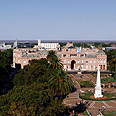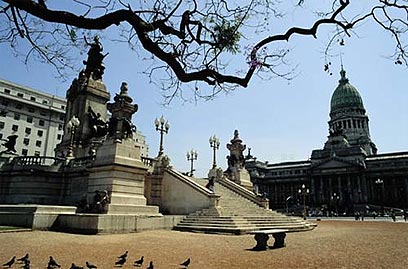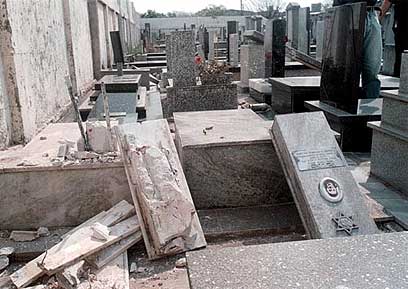

Argentine Jewry's dark secret
New book reveals story of Jewish association of pimps that operated in country in late 19th and early 20th century, and was involved in women trade and rape. 'This is a silenced story, ' author says, 'The Jewish community in Argentina remembers it well, but badly wants to keep it under wraps'
Superintendent Julio Elsogray was a strange kind of Buenos Aires cop because he would not take bribes from the pimps who dominated the city in the early 20th century. Eventually, therefore, he was the man who managed to stop them. He did that thanks to a brave whore named Rachel Lieberman, who dared file a complaint against the Zwi Migdal Organization - an association of Jewish women traders.
Thus, in 1930 the two managed to shut down the only association of Jewish panders in the world after 60 years of activity. The Zwi Migdal group was an organization that traded in women while its members wore tefillin and built themselves a synagogue, and their story is both embarrassing and exciting. It involved loads of money, corrupt politicians, violent sex, international women trade, hard brutality, rape, and cheating, all lightly spiced with yiddishkeit and God-fearing traditions.
"This is a silenced story," said writer and poet Ilan Sheinfeld, whose book "The Tale of a Ring" relates the story of that dark period. "The Jewish community in Argentina remembers it well, but badly wants to keep it under wraps because it is a disgrace. There is very little material in Hebrew about this affair."

Buenos Aires. Women import business blossomed
Intermittently researching his book for 11 years, Sheinfeld traveled to Buenos Aires twice, learned Spanish, and "established ties with Argentinean Jews who knew about the story. I had to peel off layer after layer, convince people to talk, and obtain materials. When you closely examine the affair, you can tell why it was kept secret so far."
Remonta - Fresh flesh shipment
Argentina of the second half of the 19th century was an attractive destination for Jews who fled Russian and Polish pogroms and poverty, headed for the New World. In those decades, Buenos Aires grew rapidly and with it, the Jewish community. A Hevra Kadisha was established and a newspaper named Mundo Israelita was published as the Jewish community members strove to settle down and become part of the new place. They wished to establish themselves as law-abiding and moral people.
This, however, did not apply to all of the Jews. Hundreds of Jewish immigrants chose a different path and became rufianos - pimps, prostitution peddlers. Given that at the time, there was one woman for 10 men, sexual services were in high demand. The temptation to make a profit in this area was plain to see. So the Jewish rufianos stepped in, supplied the demand, and soon enough seized control over the entire prostitution business in Argentina.
"Jews were very prominent among women traders, both as dealers and as employers of prostitutes, particularly in Argentina, Brazil, Poland, and Galicia (Russia)," wrote Yehuda Rimerman in "Prostitution and the Deviant Girl," a book that reviews the history of Jewish prostitution in the modern era. The Argentinean pimps created a total, most effective world, with predefined codewords, rules, and methods of operation. For example, a trip abroad to bring a new shipload of fresh girls was called remonta, a term taken from the horse market.
Here is how it worked: A well-mannered and elegant man would appear one day in a Jewish shtetl in Poland or Russia. He notified the local community and posted an ad in the shul saying he was looking for nice young women to work in the houses of rich Jews in Argentina or even marry them. Despairing with the pogroms and dreadful economic situation, the girls' parents would respond favorably and give their daughters away, hoping to give them a new start.
The girls, mostly aged 13 to 16, packed a small bag, bid their families a sobbing farewell, and boarded the ships to Argentina accompanied by a stranger, certain they are off to a better future. Their training period often started on the way there, on the ship, and was always a cruel and brutal affair. The young virgins were broken in - raped, beaten, starved, and locked in cages. Some of them were married off to local men so that they could obtain entry visas. Far from their families, without friends or knowledge of the language, they started serving men, their bodies belonging to the Jewish rufianos.
A cemetery fit for pimps
The largest bordellos of Buenos Aires housed 60 to 80 sex slaves. There were bordellos all over Argentina, but most of them were in the big city, in the Jewish quarter, on Junin Street.
Yet, as the whorehoses and pimps prospered, the Jewish community rejected them. Articles in the local press condemned them and, in 1885, the community established a Jewish Association for the Protection of Women and Girls. Ads posted on the walls in the Jewish quarter called on the locals not to rent their shops to the rufianos. On their part, the pimps very much wanted to be part of the community. The wealthiest among them used to pick a new girl every night and take her out to the theater, "which was the center of cultural life in the city. Jewish theater was very successful then," Sheinfeld said.
"The Jewish communities used to throw fund-raising parties, importing European star performers. The pimps would show up every night because they intended to show off their merchandise, wished to maintain their status, and also wanted be like everybody else. This is why they made donations, which made the community deliberate whether it wanted their money. On the one hand, the community needed money to build public buildings, but on the other hand, it was 'dirty' money and by taking it they feared they would be legitimizing or tacitly accepting the criminals' exploitation of women. This ended one night when Nahum Sorkin, a well-known Zionist activist, stood outside the theater and physically stopped the rufianos from entering. Next, they were banned from the synagogues, and to top it all, they were refused burial in the Jewish cemetery.
This was too much for the rufianos. It is one thing to be banned from the theater or community balls, but eternal rest is a different story. They formed an association of charity among its members. On 7 May 1906, when there were already half a million Jews in Argentina, the Jewish pimps registered legally as the Zwi Migdal Association, named after one of its greatest contributors. Naturally, the group later split and the splinter, led by Simon Rubinstein, established its own society named Ashkenazum. Once officially recognized, both associations bought plots of land on the outskirt of Buenos Aires and established their own cemeteries there.

Jewish cemetery in Buenos Aires (Photo: Reuters)
The Zwi Migdal Organization reached its peak in the 1920's, when some 430 rufianos controlled 2,000 whorehouses with 4,000 women. The network was well organized and its members cooperated closely to protect their interests. Prostitutes that failed to satisfy their clients were beaten, fined, or taken to work in provincial houses. Every business transaction was logged. The rufianos even held a meat market where newly arrived girls were paraded naked in front of traders in places such as Hotel Palestina or Cafe Parisienne. These activities went on undisturbed because they were frequented by government officials, judges, and reporters. City officials, politicians, and police officers were paid off. The pimps had powerful connections everywhere.
The hijo de puta judge
The rufianos' audacity eventually led to their demise. It happened when they refused to forgo their income from the work of one woman, Rachel Lieberman from Lódž, Poland. She, like so many others, was tempted to travel to Buenos Aires answering a matrimonial ad, but was taken to Jonin Street where she was forced to prostitute. In desperation, she contacted Superintendent Julio Elsogray. She heard his name mentioned on the street as one who would not take Zwi Migdal's money and was actually looking for ways to destroy the organization. She slipped into his office one day and gave a detailed account of the connections among the various pimps in the organization management. Her testimony was reason enough to launch an extensive investigation. This time, unlike on previous occasions that led to nothing, the findings reached Dr. Rodriguez Ocampo, a judge who would not take Zwi Migdal bribes either.
The lengthy trial ended in September 1930, with 108 detainees. "The very existence of the Zwi Migdal Organization directly threatens our society," the judge wrote in his verdict, handing down long prison terms. Nevertheless, while in prison, the pimps pulled some old strings, appealed their sentences in January 1931, and senior Justice Ministry officials left only three of the convicts in jail, discharging the rest. When the media reported this, the public was very upset and pressured the authorities to reverse the discharge decision. Thereafter, hundred of pimps were deported to Uruguay. "Over the years, they slowly returned one by one, but the era of the huge brothels ended," Sheinfeld summed up this story.















